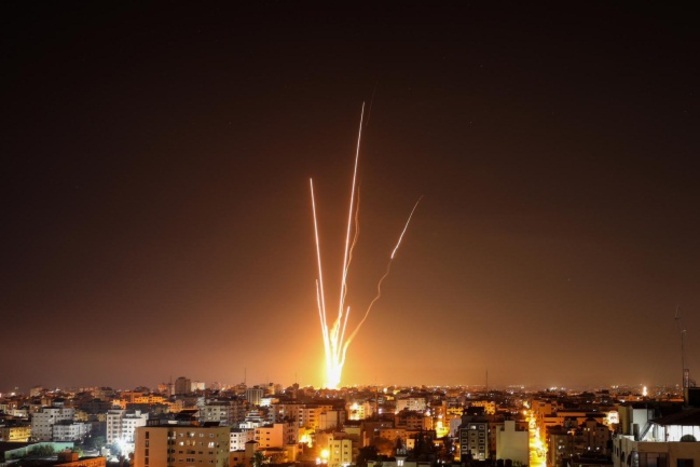On Saturday, a ceasefire was reached between Israel and the terrorist group Palestinian Islamic Jihad (PIJ), a group which seeks Israel’s annihilation, ending the fighting which began five days earlier.
Naturally, the Guardian’s postmortem on the conflict, written by Bethan McKernan and Hazem Balousha, had all the elements of bias we’ve come to expect: omitting vital context, erasing terrorists’ use of human shields while ignoring Israeli measures to avoid civilian casualties, and blaming Israel for hostilities while denying agency to Palestinians.
First, here’s how the Guardian frames the casualty count, in the piece (“Gaza ceasefire ends five days of fighting that left dozens dead”, May 14).
The violence – the most significant bout of fighting in the region in months – left 33 Palestinians dead, including at least 10 civilians, and killed an Israeli woman and a Palestinian man from Gaza working in Israel.
McKernan and Balousha fail to acknowledge the main take-away of the numbers: that the ratio of combatant to non-combatant fatalities was 1.42: 1 – showing that the IDF operation, in which 422 terrorist targets in the strip were struck, was the most successful from a humanitarian perspective in memory. In fact, all of the ten civilian casualties mentioned in their report evidently occurred in the IDF’s opening salvo, which killed three senior PIJ commanders who were responsible for directing rocket fire at Israel.
The Guardian also fails to report that four Palestinian civilians were likely killed by misfired PIJ rockets – including three children. Such misfires reportedly accounted for 20% of the 1,478 rockets and mortars fired at Israel by the terrorist group during the war.
The article also includes the following:
On Sunday morning, fishers returned to the water, and the two crossings with Israel were reopened, allowing patients from Gaza to access medical care outside the strip for the first time in days, and medicine, food and fuel to make its way in.
The Guardian neglects to mention that terrorists launched dozens of mortars toward the areas adjacent to the Erez and Kerem Shalom Crossings, which prevented their opening:
Islamic Jihad mortar shells toward the areas of the Erez Crossing and Kerem Shalom Crossing.
The fire toward the crossings prevents their opening, as it endangers the safety of the people and merchandise that cross through them.
The fire directed at the crossing is vile and… pic.twitter.com/etCi8CRu4s— Lt. Col. Richard Hecht (@LtColRichard) May 13, 2023
The cause of the war in this paragraph:
Israel and Islamic Jihad have both warned they would not hesitate to resume fire if the other side violated the agreement. Tensions have flared in the last week since the death on hunger strike in Israeli custody of Khader Adnan, a prominent political figure affiliated with the group.
In fact, “tensions flared” when, in response to the decision by Khader Adnan – who can be seen here encouraging suicide bombing – to starve himself to death while in Israeli custody, PIJ terrorists fired an unprovoked volley of over 100 rockets at Israeli cities.
The IDF operation which began last week was in response to that prior PIJ attack.
Also, Israeli Shin Bet head Ronen Bar revealed that one of the PIJ leaders killed in the IDF operation, Tareq Izz ed-Din, operated a cell in Jenin that “had begun producing rockets and launchers” to fire at Israel”, as well as another cell “thwarted in Ramallah, that was planning to fly attack drones into Israel.”
As our colleague Tamar Sternthal observed, “the West Bank production of rockets in Jenin and attack drones in Ramallah marks a new effort by Palestinian terrorists to harm Israeli civilians, further raising the risk of bloodshed and violent conflagration”.
The propagandistic reporting by McKernan and her Gaza-based colleague continues when she writes that “Gaza’s population has next to no freedom of movement“.
First, she never really mentions the reason for the blockade which, it should be stressed, doesn’t prevent strictly humanitarian goods and medical supplies from entering Gaza.
Jerusalem’s security measures relating to Gaza are in place due to Hamas, the antisemitic extremist group committed to Israel’s annihilation – proscribed as a terror group by much of the West and supported by Iran – which controls the coastal strip. They’ve fired thousands upon thousands of rockets at Israeli civilians, while PIJ, its ally in the territory and also backed (financially and militarily) by Iran, has fired thousands more.
Additionally, far from have “no freedom of movement”, there was a total of 672,000 Palestinian crossings between the Hamas-controlled territory and Israel in 2022 according to COGAT. This number includes 17,000 Gazans who enter Israel daily to work, and 13,563 Palestinians – plus over 10,000 family escorts – who left Gaza last year after being issued permits to receive medical treatment in Israel or the West Bank.
Thousands of more Palestinians cross into Egypt every year via the Rafah border.
Finally, towards the end of the piece, McKernan adds context in the way of casualty numbers:
Tensions in the Israeli-Palestinian conflict have soared over the past year: more than 130 Palestinians and at least 20 Israelis and foreigners have been killed in 2023 so far across Israel, the West Bank and the Gaza Strip.
The fact is that the overwhelming majority of the 130 Palestinians killed were either terrorists or males involved in violent clashes at the time of their death, while all except one of the Israelis killed by terrorists during this time were civilians.
Once again, the Guardian journalists gave a master class on how to portray antisemitic terrorist groups more sympathetically than the Jewish state they seek to destroy.
Editor’s Note: This post was revised on May 17th to clarify the ratio of combatants to non-combatants. It was not 2:1, but 1.42:1.
Related Posts
The Guardian plays public relations for antisemitic UN official




